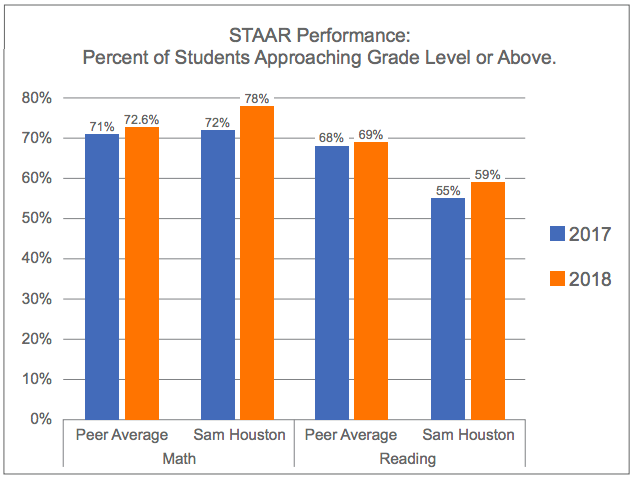EL Students at Sam Houston Middle School Outperform District Peers on Standardized Tests


EL Students at Sam Houston Middle School Outperform District Peers on Standardized Tests
Discover how Sam Houston Middle School successfully implemented Ellevation Strategies to improve their EL instruction, resulting in achievement gains in math and reading scores that exceeded the district average.
Sam Houston Middle School in Garland ISD (TX) serves nearly 1,100 students, including over 500 English learners (ELs). At 47%, Sam Houston serves more ELs on a percentage basis than the district (28%) and the state (19%). Eighty percent of Sam Houston students are economically disadvantaged, and approximately 70% were considered at risk of dropping out during the 2016-17 school year. Principal Don Hernandez and the school’s approximately 90 dedicated staff members knew they needed to reimagine their approach to EL instruction if they were going to improve student achievement for the following year.
Their solution
Making significant gains would require sustained instructional excellence and collaboration. Principal Don Hernandez knew from experience that delivering effective instruction at a large and diverse middle school is difficult. Over the years, Don and his staff had tried numerous instructional approaches but never felt any were significantly impacting outcomes for their ELs.
But in 2017 they discovered Ellevation Strategies, a solution that was designed to ensure educators could easily monitor student progress, access strategies for explicit and effective teaching, and work collaboratively with colleagues.1 At the beginning of the 2017/2018 school year, Don formed a team that set out to bring focus to ELs through the use of Ellevation Strategies and the data-driven instruction that is embedded in each of Ellevation’s instructional activities.
The implementation
When rolling Ellevation Strategies out to their district, their team chose a variety of approaches to build visibility to the product and encourage continued engagement. Teachers created videos of themselves and their peers using Ellevation activities in their lessons, which were then shown more broadly in instructional meetings. Each month, the team announced an Ellevation “Activity of the Month” in newsletters and on bulletin boards in the halls. Teachers were rewarded when seen implementing the “Activity of the Month” during instructional walkthroughs.
When reflecting back on the implementation of Ellevation, Don says: “What makes any new implementation work is teachers. They need to feel a passion for it and believe that it will help their students be successful. Our teachers really embraced Ellevation Strategies and used them in the classroom.”
The outcome
From 2017 to 2018, the percentage of ELs that achieved Approaches Grade Level or Above on the STAAR Math and Reading assessment improved 6 and 4 percentage points, respectively.

That compares to a gain of 1.6 and 1 percentage point in math and reading, respectively, for all Garland ISD middle school ELs. Furthermore, the Sam Houston Middle School Progress Domain score in math and reading was 8 and 4 points higher than the district.
The achievement among the ELs did not go unnoticed. The school received two important distinctions from the state: “Top 25 Percent: Comparative Academic Growth (AG)” (#4 in group) and “Top 25 Percent: Comparative Closing the Gaps (CTG)” (#11 in group) last year.
Ellevation Strategies was an invaluable tool in Sam Houston for supporting educators in the critical work they do every day, helping boost student achievement, and ensuring all English Learners achieve their highest aspirations. Schools and districts across the nation can use the takeaways from this middle school in Garland ISD to impact student achievement for their own EL population.
Principals Keys to Success
- Make EL achievement a priority by building strong campus teams to help drive success.
- Use Ellevation during PLCs and PD to ensure educators have a deep understanding of students and instructional strategies.
- Identify an area of focus and select an Ellevation Activity of the Week or month that aligns to that focus. Communicate this focus through newsletters and bulletin boards.
- Open your classrooms. Implement structures that increase collaboration and sharing of effective practices by scheduling walkthroughs and peer observation opportunities.
- Recognize teachers using Ellevation Strategies during walkthroughs with shout outs during announcements, faculty meetings, etc.
1In “Research-Based Methods of Reading Instruction for English Language Learners”, authors Sylvia Linan-Thompson and Sharon Vaughn write: Effective teachers—those whose students had the strongest academic outcomes—used effective instructional practices such as explicit teaching, monitoring student progress, and opportunities to practice. They also incorporated strategies that supported student acquisition of English language skills (Graves, Gersten, & Haager, 2004; Haager et al., 2003).